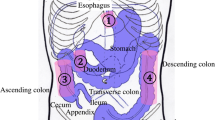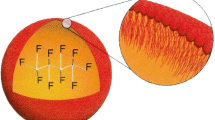Abstract
Purpose
To investigate the accuracy of laser speckle flowgraphy (LSFG), a noninvasive method for the quantitative evaluation of blood flow using mean blur rate (MBR) as a blood flow parameter in the assessment of bowel blood perfusion compared to indocyanine green fluorescence angiography (ICG-FA).
Methods
We enrolled 46 patients who underwent left-sided colorectal surgery. LSFG and ICG-FA were applied to assess blood bowel perfusion, with MBR and luminance as parameters, respectively. In both measurement methods, the position where the parameter suddenly decreased was defined as the blood flow boundary line. Subsequently, the blood flow boundaries created after processing the blood vessels flowing into the intestinal tract were determined using LSFG and ICG-FA, and concordance between the two was examined. Blood flow boundaries were visually identified using color tone changes on a color map created based on MBR in LSFG and using differences in luminance in ICG-FA. The distances between the transection line and blood flow boundaries determined using each method were compared.
Results
The location of blood flow boundaries matched in 65% (30/46) of cases. Although locations differed in the remaining 35% (16/46), all were located on the anal side near the transection line, and the difference was not clinically significant. The average distances between the transection line and blood flow boundary were 2.76 (SD = 3.25) and 3.71 (SD = 4.26) mm, respectively. There was no statistically significant difference between the two groups (p = 0.38).
Conclusion
LSFG was shown to have comparable accuracy to ICG-FA, and may be useful for evaluating bowel perfusion.






Similar content being viewed by others
Data availability
No datasets were generated or analysed during the current study.
References
Lee SW, Gregory D, Cool CL (2020) Clinical and economic burden of colorectal and bariatric anastomotic leaks. Surg Endosc 34(10):4374–4381
Wang S et al (2017) Adverse effects of anastomotic leakage on local recurrence and survival after curative anterior resection for rectal cancer: A systematic review and meta-analysis. World J Surg 41(1):277–284
Attard JA et al (2005) The effects of systemic hypoxia on colon anastomotic healing: an animal model. Dis Colon Rectum 48(7):1460–1470
Shogan BD et al (2013) Do we really know why colorectal anastomoses leak? J Gastrointest Surg 17(9):1698–1707
Shen R, Zhang Y, Wang T (2018) Indocyanine green fluorescence angiography and the incidence of anastomotic leak after colorectal resection for colorectal cancer: A meta-analysis. Dis Colon Rectum 61(10):1228–1234
Pang HY et al (2021) Indocyanine green fluorescence angiography prevents anastomotic leakage in rectal cancer surgery: a systematic review and meta-analysis. Langenbecks Arch Surg 406(2):261–271
Peltrini R et al (2021) Intraoperative use of indocyanine green fluorescence imaging in rectal cancer surgery: The state of the art. World J Gastroenterol 27(38):6374–6386
Boyle NH et al (2000) Intraoperative assessment of colonic perfusion using scanning laser Doppler flowmetry during colonic resection. J Am Coll Surg 191(5):504–510
Jansen-Winkeln B et al (2022) Border line definition using hyperspectral imaging in colorectal resections. Cancers (Basel) 14(5):1188
Wada T et al (2017) ICG fluorescence imaging for quantitative evaluation of colonic perfusion in laparoscopic colorectal surgery. Surg Endosc 31(10):4184–4193
De Nardi P et al (2020) Intraoperative angiography with indocyanine green to assess anastomosis perfusion in patients undergoing laparoscopic colorectal resection: results of a multicenter randomized controlled trial. Surg Endosc 34(1):53–60
Watanabe J et al (2021) Evaluating the effect of intraoperative near-infrared observation on anastomotic leakage after stapled side-to-side anastomosis in colon cancer surgery using propensity score matching. Dis Colon Rectum 64(12):1542–1550
Hope-Ross M et al (1994) Adverse reactions due to indocyanine green. Ophthalmology 101(3):529–533
Fujii H et al (1987) Evaluation of blood flow by laser speckle image sensing. Part 1. Appl Opt 26(24):5321–5
Sugiyama T et al (2010) Use of laser speckle flowgraphy in ocular blood flow research. Acta Ophthalmol 88(7):723–729
Nagashima Y, Ohsugi Y, Niki Y, Maeda K, Okamoto T (2015) Assessment of laser speckle flowgraphy: development of novel cutaneous blood flow measurement technique. In: Proceedings SPIE 9792, Biophotonics Japan 2015, 979218. https://doi.org/10.1117/12.2203712
Kaneko T et al (2020) Noninvasive assessment of bowel blood perfusion using intraoperative laser speckle flowgraphy. Langenbecks Arch Surg 405(6):817–826
Rønn JH et al (2019) Laser speckle contrast imaging and quantitative fluorescence angiography for perfusion assessment. Langenbecks Arch Surg 404(4):505–515
Rasband WS (1997–2014) ImageJ [Document on the Internet]. U. S. National Institutes of Health, Bethesda, Maryland, USA. http://imagej.nih.gov/ij/. Accessed 20 Feb 2020
Davis MA, Kazmi SM, Dunn AK (2014) Imaging depth and multiple scattering in laser speckle contrast imaging. J Biomed Opt 19(8):086001
Frangioni JV (2008) New technologies for human cancer imaging. J Clin Oncol 26(24):4012–4021
Atkinson NSS et al (2017) How to perform gastrointestinal ultrasound: Anatomy and normal findings. World J Gastroenterol 23(38):6931–6941
Watanabe J et al (2020) Indocyanine green fluorescence imaging to reduce the risk of anastomotic leakage in laparoscopic low anterior resection for rectal cancer: a propensity score-matched cohort study. Surg Endosc 34(1):202–208
Heeman W et al (2023) Dye-free visualisation of intestinal perfusion using laser speckle contrast imaging in laparoscopic surgery: a prospective, observational multi-centre study. Surg Endosc 37(12):9139–9146
Nwaiwu CA et al (2023) Real-time first-in-human comparison of laser speckle contrast imaging and icg in minimally invasive colorectal & bariatric surgery. J Gastrointest Surg 27(12):3083–3085
Acknowledgements
We would like to thank Editage (www.editage.jp), for English language editing.
Author information
Authors and Affiliations
Contributions
T.K, and K.F established a study conception and design.
M.U, K.Y, Y.M and A.K acquired the data.
S.K,Y.I and T.S analyzed and interpreted the data.
T.K prepared the manuscript.
K.F revised the manuscript.
Corresponding author
Ethics declarations
Ethics approval
This study was approved by the Ethics Committee of Toho University Omori Hospital (M17229).
Informed consent
Written informed consent was obtained from all subjects involved in the study.
Competing interests
The authors declare no competing interests.
Additional information
Publisher's Note
Springer Nature remains neutral with regard to jurisdictional claims in published maps and institutional affiliations.
Rights and permissions
Springer Nature or its licensor (e.g. a society or other partner) holds exclusive rights to this article under a publishing agreement with the author(s) or other rightsholder(s); author self-archiving of the accepted manuscript version of this article is solely governed by the terms of such publishing agreement and applicable law.
About this article
Cite this article
Kaneko, T., Funahashi, K., Ito, Y. et al. Laser speckle flowgraphy has comparable accuracy to indocyanine green fluorescence angiography in assessing bowel blood perfusion. Langenbecks Arch Surg 409, 147 (2024). https://doi.org/10.1007/s00423-024-03338-4
Received:
Accepted:
Published:
DOI: https://doi.org/10.1007/s00423-024-03338-4




